
The Marienwerder Region was a government region (Regierungsbezirk) of Prussia from 1815 until 1920 and again 1939-1945. It was a part of the Province of West Prussia from 1815 to 1829, and again 1878–1920, belonging to the Province of Prussia in the intervening years, and to the Reichsgau Danzig-West Prussia in the years 1939-1945. The regional capital was Marienwerder in West Prussia.

The Bromberg district was a Prussian district that existed from 1772 to 1807 and then from 1815 to 1920. It initially belonged to the Netze District and from 1815 it was part of Regierungsbezirk Bromberg in the Grand Duchy of Posen and from 1848, the Prussian Province of Posen. The city of Bromberg was detached from the district and formed its own urban district since 1875. Today, the territory of the district is part of the Kuyavian-Pomeranian Voivodeship in Poland.

The Danziger Höhe was an administrative district founded in 1887 and dissolved in 1939. The district administration was based in the City of Danzig, which itself did not form part of the district but was an independent city (Stadtkreis). The area Danziger Höhe covered is now within Poland.
Landkreis Marienwerder was a Kreis, or district, of Prussia from 1752 to 1945. Its capital was Marienwerder (Kwidzyn).
The West Prussia Region was a government region (Regierungsbezirk) of Prussia from 1920 until 1939. The regional capital was Marienwerder in West Prussia. It was the eastern part of Marienwerder Region which voted to be incorporated within the Weimar Republic and joined the Province of East Prussia from 1922 to 1939. It was replaced again by the reconstituted Marienwerder Region in 1939 until its dissolution in 1945.

The Danzig Region was a government region, within the Prussian Provinces of West Prussia and of Prussia. The regional capital was Danzig (Gdańsk). Prussian government regions were not bodies of regional self-rule of the districts and cities comprised, but shear top-to-down government agencies to apply federal or state law and supervise local entities of self-rules, such as municipalities, rural and urban districts.
Babidół is a village in the administrative district of Gmina Kolbudy, within Gdańsk County, Pomeranian Voivodeship, in northern Poland. It lies approximately 3 kilometres (2 mi) south-west of Kolbudy, 13 km (8 mi) west of Pruszcz Gdański, and 18 km (11 mi) south-west of the regional capital Gdańsk.
Arciszewo is a village in the administrative district of Gmina Pruszcz Gdański, within Gdańsk County, Pomeranian Voivodeship, in northern Poland. It lies approximately 5 kilometres (3 mi) west of Pruszcz Gdański and 13 km (8 mi) south of the regional capital Gdańsk.
Będzieszyn is a village in the administrative district of Gmina Pruszcz Gdański, within Gdańsk County, Pomeranian Voivodeship, in northern Poland. It lies approximately 4 kilometres (2 mi) south-west of Pruszcz Gdański and 14 km (9 mi) south of the regional capital Gdańsk.
Borowina is a village in the administrative district of Gmina Przywidz, within Gdańsk County, Pomeranian Voivodeship, in northern Poland. It lies approximately 5 kilometres (3 mi) south of Przywidz, 25 km (16 mi) south-west of Pruszcz Gdański, and 32 km (20 mi) south-west of the regional capital Gdańsk.

The Karthaus district was a Prussian district that existed from 1818 to 1920. It was located in the part of West Prussia that fell to Poland after World War I through the Treaty of Versailles in 1920, as part of the Polish Corridor. The capital of the district was Karthaus. From 1939 to 1945, the district was re-established as part of Reichsgau Danzig-West Prussia in occupied Poland. Today the territory of the district lies in the Polish Pomeranian Voivodeship.
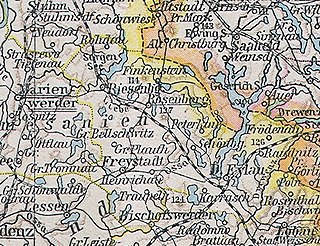
The district of Rosenberg in Westpreußen was a Prussian district that existed from 1818 to 1945. The territory of the district is now located within the Polish Warmian-Masurian Voivodeship.
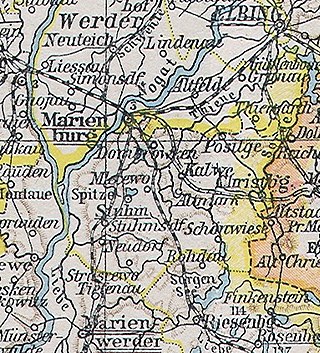
The Stuhm district was a Prussian district that existed between 1818 and 1945. It belonged to the part of West Prussia that remained in the German Reich after World War I and was since part of the province of East Prussia. Today, the territory of the district is located in the Pomeranian Voivodeship in Poland.
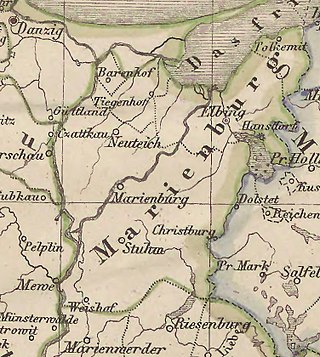
The Marienburg district was a Prussian district that existed from 1772 to 1945. The district originally belonged to the province of West Prussia and was divided in 1920 by the Treaty of Versailles. Its western half fell to the Free City of Danzig, while its eastern half became part of the province of East Prussia and remained in the German Reich until 1945. The district capital was Marienburg. The territory of the district is now part of the Pomeranian Voivodeship in Poland.
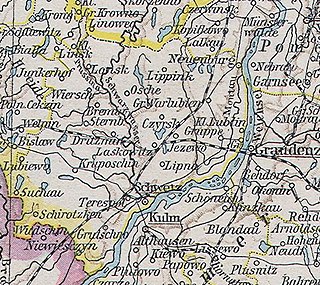
Kreis Schwetz was a Prussian district that existed from 1818 to 1920, with its capital at Schwetz. The district was located on the western bank of the Vistula river in the part of West Prussia that fell to Poland after the First World War through the Treaty of Versailles in 1920.

The district of Graudenz was a Prussian district in the administrative region of Marienwerder that existed from 1818 to 1920. It belonged to the province of West Prussia until 1829 and then again from 1878 to 1920. Between 1829 and 1878, it belonged to the Province of Prussia. It was located in the part of West Prussia that fell to Poland after the World War I in 1920 through the Treaty of Versailles. The city of Graudenz, was part of the district until 1900, after which it formed its own independent urban district.
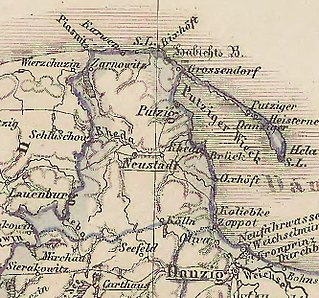
The Neustadt district was a Prussian district that existed from 1818 to 1920. It was in the part of West Prussia that fell to Poland after World War I through the Treaty of Versailles. From 1939 to 1945 the district was re-established in occupied Poland as part of the Reichsgau Danzig-West Prussia. Today the area of the former district is in the Polish Pomeranian Voivodeship.

The Berent district was a Prussian district that existed from 1818 to 1920. It was in the part of West Prussia that fell to Poland after World War I in 1920. Its capital was Berent. From 1939 to 1945, the district was re-established in German-occupied Poland as part of the newly established Reichsgau Danzig-West Prussia. Today the territory of the district is located in the Polish Pomeranian Voivodeship.

The district of Thorn was a Prussian district in the Marienwerder administrative region that existed from 1818 to 1920. It belonged to the province of West Prussia, except for the period from 1829 to 1878 when it was part of the Province of Prussia. Its capital was Thorn. It was in the part of West Prussia that fell to Poland after World War I in 1920 through the Treaty of Versailles. From 1939 to 1945, the district of Thorn was re-established in Reichsgau Danzig-West Prussia in occupied Poland. Today, the area of the district is in the Kuyavian-Pomeranian Voivodeship in Poland.

The Preußisch Stargard district was a Prussian district that existed from 1772 to 1920 with varying borders. It was in the part of West Prussia that fell to Poland after World War I through the Treaty of Versailles in 1920. Its county seat was Preußisch Stargard. From 1939 to 1945 the district was re-established in German-occupied Poland as part of the newly established Reichsgau Danzig-West Prussia. Today the territory of the district is located in the Polish Pomeranian Voivodeship.















